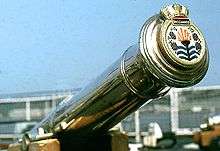Tampion
A tampion or tompion (in the Royal Navy)[1] is a wooden plug, or a metal, canvas, rubber, or plastic cover, for the muzzle of a gun or mortar.[2] Tampions can be found on both land-based artillery and naval guns. Naval tampions have developed into works of art.

History
Although the cannon of ships of the line were protected as they were retracted inside the ships, many smaller vessels had exposed gundecks which required a plug to protect inside of the barrels. To combat rust when ships were not in action the barrels were sealed, both with a tampion and plugs in the touch hole. A quantity of olive oil and a round shot were left inside in the barrel; With the gun laid horizontally the shot would roll up and down the barrel as the ship caught each wave, effectively lubricating the gun simply through the motion of the ship.[3]
Later, the invention of mobile gun turrets meant that all guns were constantly exposed to water. Hence, when not in use, naval guns were protected by wooden, and, later, rubber, muzzle plugs. They were also used to protect the barrel whenever the guns were placed in storage, for example in the hold where moisture could cause corrosion, and sealed in with putty.[4]
Typically, rubber and plastic tampions can be shot through in case of an emergency. Plastic tampions are normally designed to be expelled by the build-up of pressure in the barrel as the first shell is fired.
Over time, tampions were embossed or engraved with the arms of the unit, and they became collector's items. Nowadays, even warships that typically would not carry heavy guns, such as submarines, have their own badges in the shape of a tampion.
References
- Simmons, 1812, p. 163.
- Duane, 1810, p. 678.
- Morris, 2006, p. 110.
- Simmons, 1812, p. 65.
Further reading
- Duane, William (1810). A Military Dictionary. Philadelphia: William Duane.
- Morris, Roland (2006). HMS Colossus, the Story of the Salvage of the Hamilton Treasures. Penzance: Periscope Publishing Ltd.
- Simmons, Robert (1812). The Sea Gunner's Vade-Mecum, being a new introduction to Practical Gunnery, expressly accommodated to the use of the Royal Navy. London: Steel & Co.
Images
 The muzzle of a 36-pounder cannon on the preserved ship of the line, HMS Victory. The red tampion is secured with a cord
The muzzle of a 36-pounder cannon on the preserved ship of the line, HMS Victory. The red tampion is secured with a cord The tampions of the 15-inch guns on the British battleship HMS Queen Elizabeth in 1917
The tampions of the 15-inch guns on the British battleship HMS Queen Elizabeth in 1917 A sailor polishing the tampion of an 8-inch gun on the Australian heavy cruiser, HMAS Australia in the early 1950s.
A sailor polishing the tampion of an 8-inch gun on the Australian heavy cruiser, HMAS Australia in the early 1950s. Tampion of a brass cannon with the crest of the British Leander-class frigate, HMS Bacchante in 1976
Tampion of a brass cannon with the crest of the British Leander-class frigate, HMS Bacchante in 1976 Tampion on the 4.5 inch gun of the British Type 23 frigate, HMS Argyll in 2014
Tampion on the 4.5 inch gun of the British Type 23 frigate, HMS Argyll in 2014 The unadorned tampions of the 16-inch guns on the US battleship, USS Missouri in 2002
The unadorned tampions of the 16-inch guns on the US battleship, USS Missouri in 2002 The 100 mm gun of the French frigate Prairial sealed by a tampion
The 100 mm gun of the French frigate Prairial sealed by a tampion Tampion of the French cruiser Jeanne d'Arc
Tampion of the French cruiser Jeanne d'Arc Tampion of the French submarine Rubis
Tampion of the French submarine Rubis Tampion of the French submarine Émeraude
Tampion of the French submarine Émeraude
| Wikimedia Commons has media related to Tampions. |